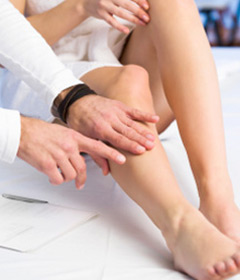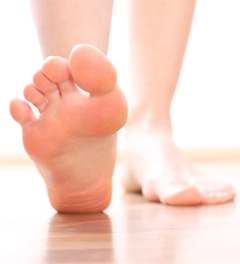|
|
Botox for Foot Wounds
 It's
been used for
wrinkles,
muscle spasms and even Tourette syndrome. Now
Botox may now save limbs from amputation. It's
been used for
wrinkles,
muscle spasms and even Tourette syndrome. Now
Botox may now save limbs from amputation.
Each
year, foot ulcers lead to more than 82,000 amputations. They�re a devastating
complication of
diabetes. Type II, or adult onset, diabetes accounts for most cases of the
disease. People who are overweight, have a family history of diabetes, are over
age 45, were gestational diabetics (women who had high blood sugar levels during
pregnancy), or are African American, Latin American, Native American, or Asian
and Pacific Islanders, have a higher risk of developing diabetes than others.
Symptoms of Type II diabetes include extreme thirst, excessive urination,
unexplained weight loss, blurred vision, and tingling or numbness in the hands
or feet.
The
sole, or plantar surface, of the foot is the most common location for an ulcer.
Problems can begin with something as seemingly innocuous as a bunion or a
hammertoe and a poorly fitting shoe that rubs against these deformities. "Every
time you have an ulcer, this is just one more opportunity to develop a
limb-threatening infection that might require an amputation," says Jeffrey
Johnson, M.D., an orthopedic foot and ankle surgeon from Barnes-Jewish Hospital
at Washington University School of Medicine in St. Louis.
Researchers at Washington University say healing the ulcers is tough, but
keeping them healed is tougher. Dr. Johnson says: "The problem is the recurrence
rate is very high. Within the first month after healing these ulcers ... 60
percent or 80 percent of patients will re-ulcerate during that time."
Now, researchers are turning to Botulinum Toxin Type A, or Botox -- a poison
that�s commonly used to treat wrinkles.

Wounds
are most common on the ball of the
foot, and
the pressure on wounds is highest when a person walks. That�s where Botox comes
in. "What the botulism will do is weaken that muscle, the muscle that pushes you
forward during
walking, and so then you can�t develop the high pressures under the front of
your foot," says Mary Hastings, a physical therapist at Washington University
who is leading the study. Botox allows time for the ulcer to heal.
In
a new study, doctors will inject Botox in six different places in the calf
muscle. Then, they�ll cast it. They know the Botox will weaken the muscle, and
they hope that�s enough to keep the wounds healed.
"The more time you spend without a sore on the bottom of the foot, the less
chance you have for an infection that will develop into the potential for a need
for an amputation," Hastings says.
The study has already started enrolling patients. And for the more than 18
million diabetics in the Unites States, that�s encouraging news.
Botox is already approved by the FDA to treat other medical conditions. Daily
inspections of your feet are the best way to prevent infections, but if they do
occur, you need a healthcare team with special expertise in diabetic foot
problems.
Shoe selection and modifications :
|
-
Obtain well-cushioned walking shoes
-
Shoes should have adequate room in toe box
-
Consider custom molded shoes
-
Break in a new shoe gradually
-
Reduce pressure points
-
Cushioned insole
-
Custom Orthotic
|
Dated 15 August 2013
Related Links
|
|
|
|
|









